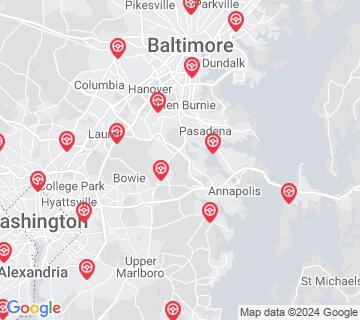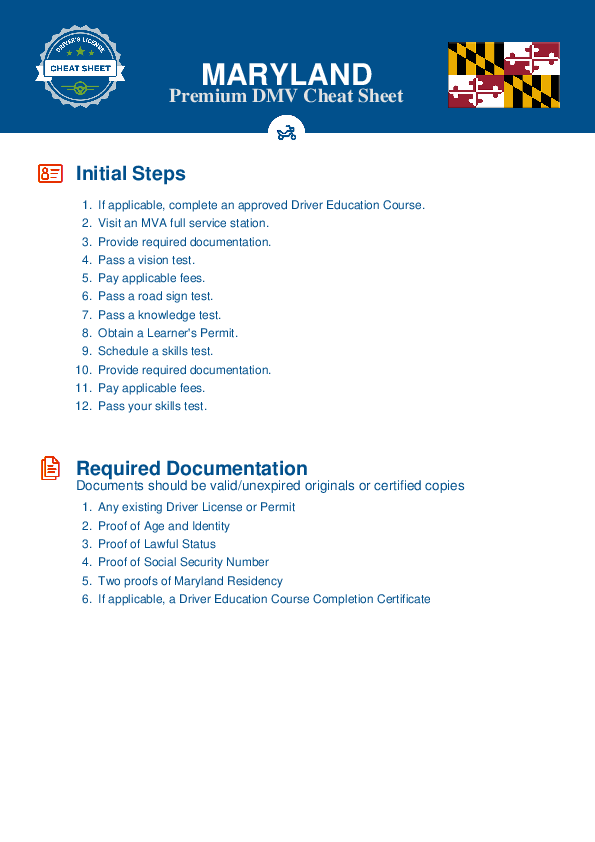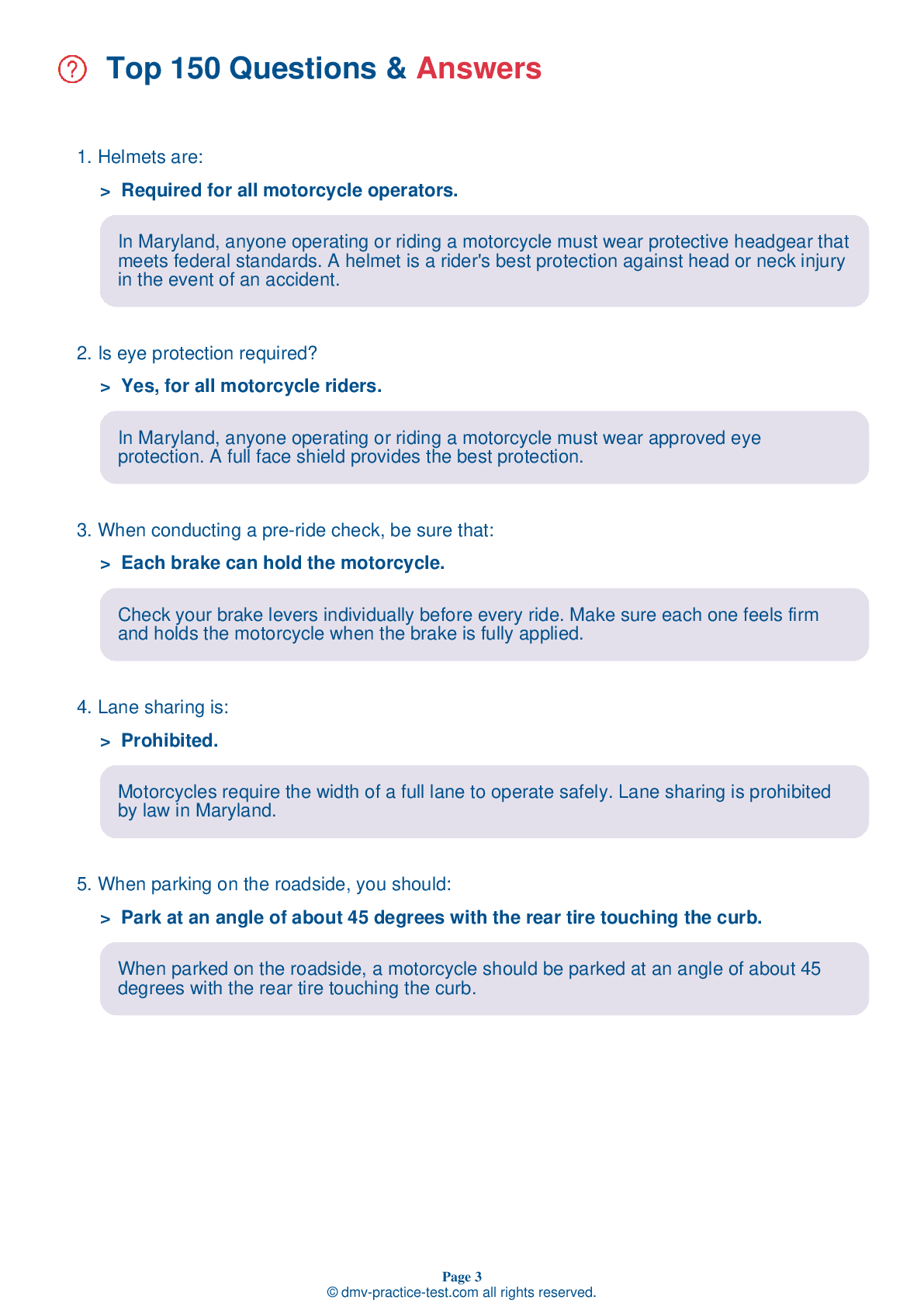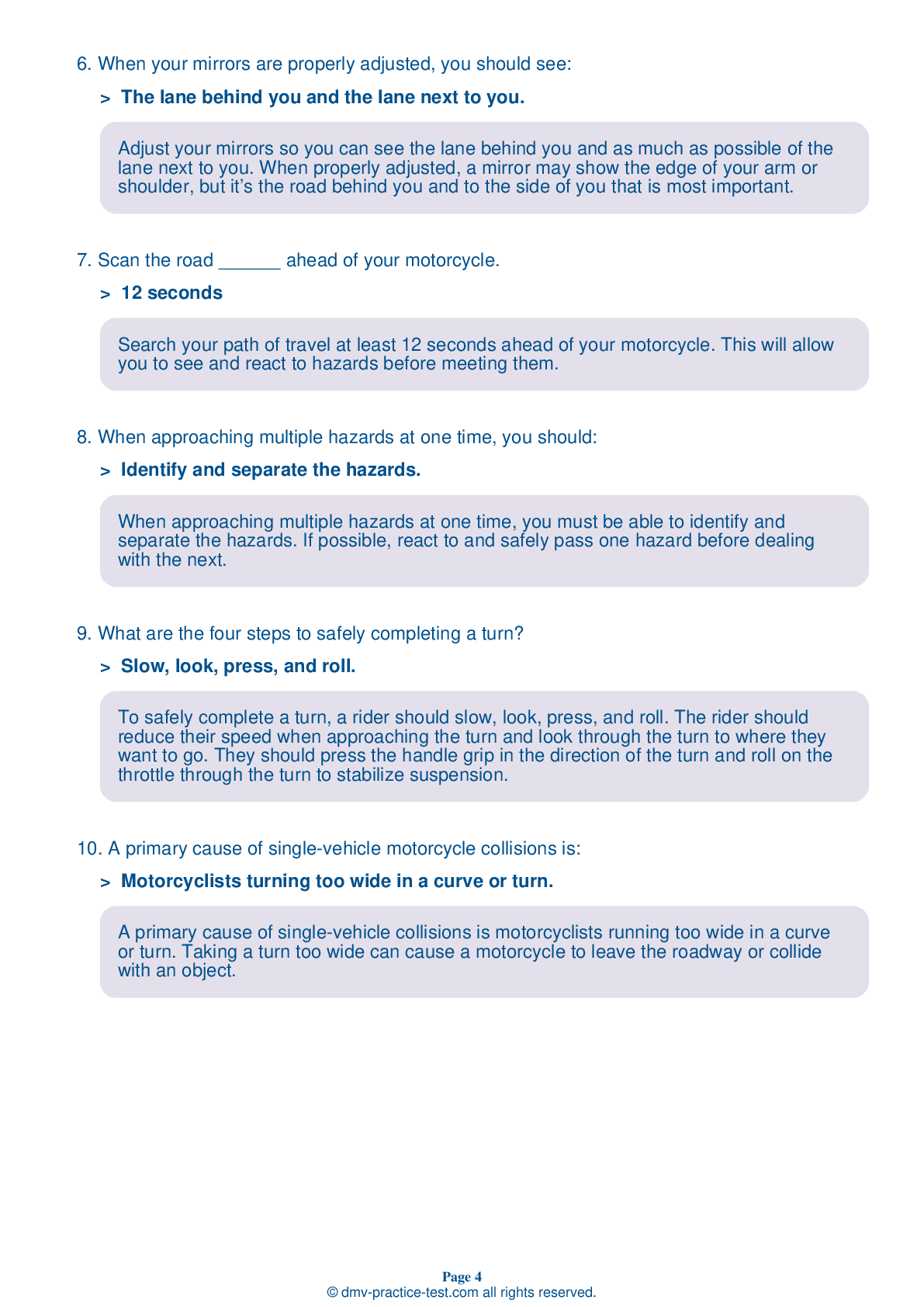DMV Permit Test #15
Motorcycle Test | License MD 2025 | FREE Online Practice! #15
Take this FREE motorcycle test (license in MD 2025) to check your knowledge of the road rules. To improve your results, download a motorcycle handbook online, study theory, and practice for free on our website. Still worried about how to get a motorcycle license in Maryland in 2025? Check our website for more sample tests, train as much as possible, and boost your grades!
25
21
16
1 . When following a car, usually the best portion of the lane to ride in is:
The left or right portions.
When riding behind a passenger vehicle, it is usually best to ride in the center of the lane so you will be visible in the driver's rearview mirror. Most drivers check their rearview mirrors much more often than their side mirrors, so this lane position will increase your chances of being seen.
2 . When passing, you:
May ride 15 mph above the maximum speed limit.
Passing must be completed within posted speed limits. Only pass another vehicle where it is safe and legal to do so.
3 . If a friend has been drinking and wants to ride their motorcycle, you should:
Encourage friends to talk them out of riding.
Never let someone ride if they have had too much to drink. Do whatever you can to prevent them from riding. It can be helpful to recruit a group of friends to intervene and apply peer pressure to the person.
4 . The single most effective thing you can do to improve your chances of surviving an accident is:
Watch training videos.
The single most important measure you can take to reduce your risk of injury or death in the event of an accident is to wear a helmet.
5 . Which of the following is not a factor in determining blood alcohol content (BAC)?
How often the drinker consumes alcohol
The three major factors that affect a person's blood alcohol content (BAC) are the amount of alcohol consumed, how fast the alcohol was consumed, and the drinker's body weight. It is illegal and dangerous to operate a motor vehicle while under the influence of alcohol.
6 . When you are being passed by a vehicle on your left, you should:
Ride in the left portion of your lane
When being passed, it is best to ride in the center portion of your lane. Riding on the side nearest to the passing vehicle increases the risk of a collision. Riding on the side farthest from the passing vehicle is also dangerous because it may tempt them to merge back into your lane too soon. Stay in the center portion of the lane when being passed.
Search the best driving school in your neighbourhood
2025 Maryland | Frequently Asked Questions
To acquire a motorcycle license in Maryland, you must first obtain a Class M motorcycle learner's permit by passing a vision test and knowledge test at a Maryland MVA office. After this, you must complete the Maryland Motorcycle Safety Program's Basic Rider Course. Upon successful completion, you can then apply for a full Class M license at the MVA.
In Maryland, the minimum age for obtaining a motorcycle driver's license is 16 years and 6 months. However, if you're under 18, you must complete the Maryland Motorcycle Safety Program's Basic Rider Course. Additionally, minors need to have their parent's or guardian's consent and should have held a learner's permit for at least 9 months.
Yes, in Maryland, you need a separate, specific license to operate a motorcycle, known as a motorcycle endorsement. This is in addition to a standard driver's license. It requires passing a written exam and a skills test. The process ensures that motorcycle riders have the necessary skills and knowledge for safe operation.
To apply for a motorcycle driver's license in Maryland, you'll need to provide proof of identity (like a birth certificate or passport), proof of Social Security (like a Social Security card or W-2 form), and two proofs of Maryland residency (like utility bills or bank statements). You'll also need to pass vision and knowledge tests, and complete a motorcycle safety course.
Yes, to obtain a motorcycle license in Maryland, you will need to pass a written exam. This exam tests your knowledge of motorcycle operation, traffic laws, and safe riding techniques. However, if you complete a Maryland Motorcycle Safety Program course, the written and skills test may be waived. Always check with the Maryland Motor Vehicle Administration for current requirements.
The written motorcycle test in Maryland covers a variety of subjects related to motorcycle safety and operation. These include traffic laws, road signs, safe riding techniques, handling dangerous situations, and the effects of alcohol and drugs on riding. The test is based on the information contained in the Maryland Motorcycle Operator Manual.
No, in Maryland, you cannot substitute the written test with a motorcycle training course. The training course can waive the skills test but not the written one. The written test is mandatory to ensure that you understand traffic laws, road signs, and safe riding techniques before you get your motorcycle license.
To enroll in a motorcycle training course in Maryland, first find a Motor Vehicle Administration (MVA) approved course provider. You can do this online or by calling the MVA. Once you've chosen a provider, contact them directly to enroll. Some providers allow online enrollment, while others may require you to call or visit in person. Fees and schedules vary by provider.
No, you don't have to own the motorcycle used for the license test in Maryland. The motorcycle can be borrowed but it must be registered, insured, and pass all safety standards. However, unless you have a valid motorcycle learner's permit, a licensed motorcycle operator must bring the bike to the test site.
Yes, you can use a friend's motorcycle for the Maryland motorcycle license test, provided it's registered, insured, and meets safety standards. However, you must have a valid motorcycle learner's permit or a licensed motorcycle operator must bring the bike to the test site for you. Always check with your local Motor Vehicle Administration office for specific rules.
Yes, in Maryland, the motorcycle driving exam tests specific handling skills. These include ability to start and stop, turn and swerve, quick stop, obstacle swerve, and cone weave. The test is designed to assess your ability to control the motorcycle under various circumstances, ensuring safety on the road.
Yes, in Maryland, new motorcycle drivers under the age of 18 are required to complete a Basic Rider Course. They also have a provisional license period, which includes restrictions like no passengers, no driving between midnight and 5 am, and zero alcohol tolerance. These restrictions are lifted after 18 months of clean driving record.
Yes, your Maryland motorcycle license is valid across the United States. It allows you to legally operate a motorcycle in all other states. However, you must observe the traffic laws of the state you are in, as they may differ from those in Maryland. Always check local regulations when traveling to unfamiliar areas.
Yes, it is mandatory to wear a helmet when operating a motorcycle in Maryland. According to Maryland's law, all motorcycle drivers and passengers are required to wear a helmet that meets the safety standards set by the U.S. Department of Transportation. Additionally, eye protection is required unless the motorcycle is equipped with a windscreen.
Yes, Maryland offers two types of motorcycle licenses: Class M and Class M with a J restriction. A Class M license allows you to operate any motorcycle. A Class M license with a J restriction is for mopeds and motor scooters only. The type of license you need depends on the type of motorcycle you intend to drive.
Yes, in Maryland, you can add supplementary endorsements to your motorcycle license. Endorsements allow for the operation of different types of vehicles such as motorcycles, school buses, and commercial vehicles. To add an endorsement, you typically need to pass both a written test and a skills test related to the specific type of vehicle.
Yes, it is possible to take the motorcycle license test in Maryland in various languages other than English. The Maryland Motor Vehicle Administration (MVA) offers the test in languages like Spanish, Korean, French, etc. However, you should contact your local MVA office beforehand to check the availability of your preferred language.
An effective strategy to prepare for the motorcycle license test in Maryland is to study the Maryland Motorcycle Operator Manual thoroughly. It covers all topics that will be on the test. Additionally, taking practice tests online can be beneficial as they simulate the actual exam environment, helping you understand the format and type of questions asked.
Yes, the motorcycle written test in Maryland can be taken in several languages other than English. The Maryland Motor Vehicle Administration (MVA) offers the test in Spanish, Korean, French, and more. However, it's recommended to contact your local MVA office ahead of time to confirm the availability of your preferred language.
If you don't pass the motorcycle written test in Maryland, you will be allowed to retake it. However, you must wait at least one day before your next attempt. If you fail the test three times, you'll be required to wait 7 days before retaking it. You must also pay a re-examination fee each time.




